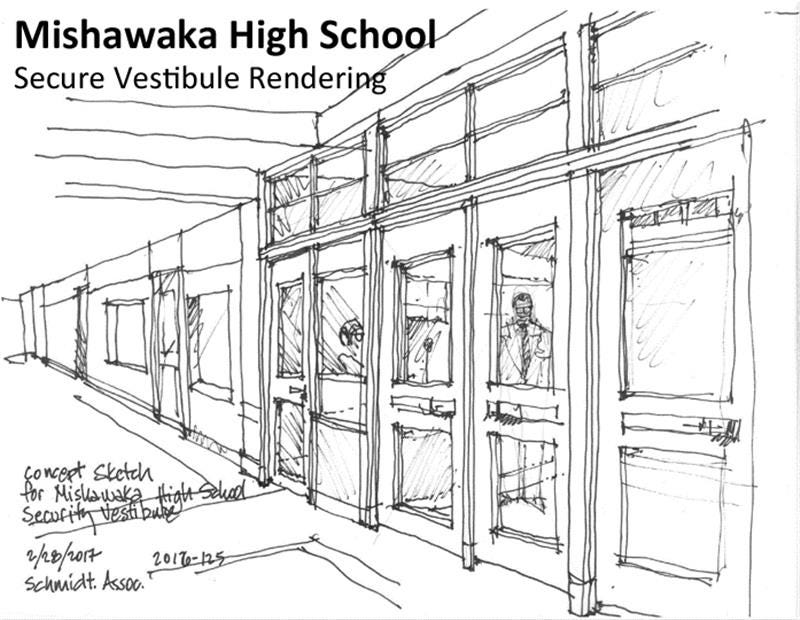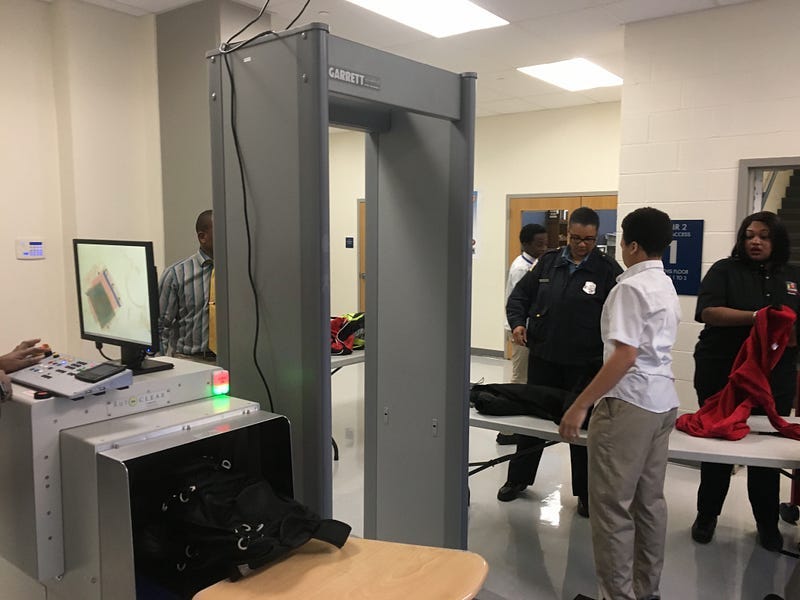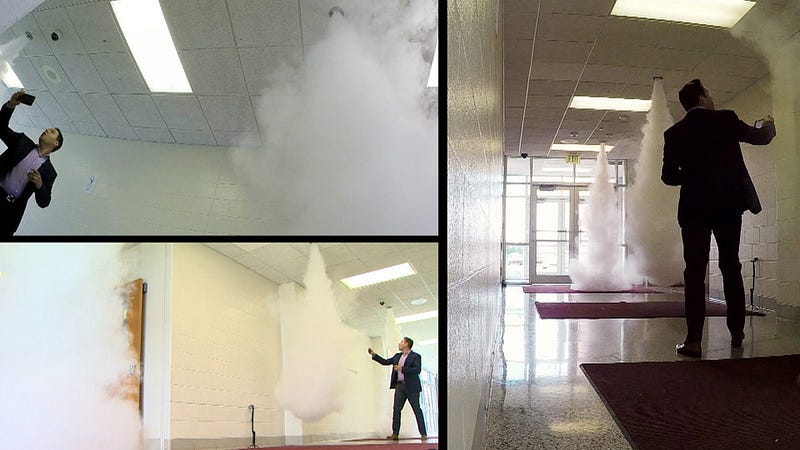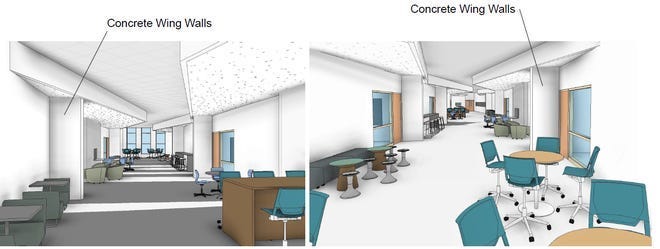What is ‘school security’?
In the wake of the Uvalde massacre, President Biden signed the first bipartisan gun legislation in generations. Included in the bill is…
In the wake of the Uvalde massacre, President Biden signed the first bipartisan gun legislation in generations. Included in the bill is $300 million in federal grant funding for “school security”. On the surface this provision seems fairly simple - more security would indeed stop the next school shooting. Unfortunately, like any problem of great complexity, things are never as simple as they seem.
Most security — in all kinds of places from stadiums to airports to office buildings — is designed to keep people out. Fences, walls, and locked doors prevent an intruder from getting in. When people enter, there is verification that they are allowed to be in the building (e.g., ID card, reason for visit) and often a security screening for weapons or contraband (e.g., bag check, metal detector). This type of process works quite well for a government office building where everyone who is allowed inside has an ID badge, and visitors are escorted and screened for weapons.
Schools are quite different than government buildings. There are a lot of schools — about 98,000 across the country — with 49.4 million students. Many different people, both children and adults, have a valid reason to be at the school and need to bring things with them. Security isn’t as simple as checking IDs and scanning backpacks.
Components of school security
School security has four different components: the physical campus, security equipment added to it, procedures and training for how to use the equipment, and personnel to carry out the procedures:
Physical Campus: All the things in and around the school that allow for, or limit access, such as fences, gates, doors, and walls. Not all schools are a brick schoolhouse with a front door, long hallways, and square windows. Many public schools have open-air campuses with dozens of different buildings.
2. Equipment: All the things specifically designed to secure the campus such as camera systems, metal detectors and body scanners, door locks, ID card readers, public address systems, and text notification systems.
3. Procedures and training: Formal process of using equipment to secure the campus. For example, locking all exterior doors when a threat is reported near the campus, or screening all students and visitors who enter the school building are procedures for using the security equipment. If a school has a metal detector, staff need training and procedures for what to do when it beeps, malfunctions, turns off, etc.
4. Personnel: People who use the security equipment and follow the procedures including dedicated security and SROs, teachers, other staff, and students.
Unlike an airport, sports arena, or office building that increases security to keep unwanted people out, most school shootings are committed by someone who has permission to be on the campus and is trained in the security procedures. Physical security has limited utility against an insider threat.
Pros and Cons of Security Equipment
With billions of dollars in federal, state, local, and private money being spent on school security, there are several key items that money can used for. Like any big purchase, each item has pros and cons that need to be considered.
It’s important to remember that with any equipment purchase, items only work if staff are trained on their use, there are procedures for use, and ongoing maintenance keeps them functional. If a school spends $10,000 on a metal detector, the staff at the door need to know how to properly operate it, have a formal screening procedure for who gets screened, when, and by whom, what to do if a weapon is found, and ongoing service to keep it working properly.
CCTV: Cameras to record things going on in or around the school.
Pros: Beyond a shooting, cameras are useful to investigate drug use, vandalism, fights, thefts, or any other illegal activity on school property.
Cons: Most cameras record what already happened. It would take a dedicated staff to monitor hundreds of cameras to identify a shooter on the campus in real-time.
Panic Button: Emergency button in a classroom that calls 911
Pros: Can be used for active shooter or any other emergency in the classroom, such as an urgent medical problem or fight between students.
Cons: Kids love to play with things, especially things they aren’t allowed to touch. Every time a classroom panic button is a false alarm, less attention will be given to the next one. When a fire alarm goes off, how many people think there actually is a fire? We get conditioned into complacency.
Automated Notification System: System that sends text messages to all registered users
Pros: Can rapidly provide information about a school shooting, weather emergency, fire, power outage, and closure or delayed opening.
Cons: If a teacher has their phone in their pocket, bag, or desk drawer, they won’t see the alert. You don’t want a teacher to stop teaching every time their phone buzzes. For all the other users, if you send too many messages, people stop paying attention.
Text/App Active Reporting System: System for anonymously reporting issues
Pros: Can be used by staff and students to report school shooting threats, other threats of violence, sexual assault, abuse, or criminal activity.
Cons: System can be spammed, and students can anonymously report threats to get classes cancelled during exams or as pranks against rival schools. Someone has to evaluate and investigate every report that comes into the system. If an attack happens and the school system overlooked a threat that was reported through the system, the school system could be liable for damages.
Metal detectors/body scanners: Equipment for screening anyone who enters
Pros: If everyone is screened and there is no way to bypass the screening, nobody will have a weapon on campus. Beyond guns, this equipment can detect firearms, knives, other weapons, bombs, and drugs/vaping devices.
Cons: Metal detectors are only useful if everyone is screened at all points of entry. On a large, open campus, this may not be possible. If metal detectors are only at the front door, students can easily bypass them by throwing a bag over the fence or being let in a back door. Staff operating the metal detector also need a level of force that matches the weapons they’re screening for. If the person conducting screenings is looking for guns, they should also be armed with a gun. Screening equipment isn’t a one time purchase - it requires ongoing maintenance and staff need recurring training to ensure they’re using it correctly.
Locking Classroom Doors
Pros: A locked door keeps intruders out of the room.
Cons: If a shooting committed by a student starts inside the classroom, a locked door can keep police out. Adolescents tend to enjoy pranks and students may lock teachers out of the room. If interior locks are added to closets, workrooms, lounges, offices, and other areas that students might hide from an active shooter, students may go into these lockable rooms to use drugs and have sex.
Fencing
Pros: Fences serve as a deterrent to keep intruders out. During large events like high school football games, fences move crowds towards exits or points of entry. Fences can also keep small children from running away from the campus during recess.
Cons: Fences can be climbed over, vehicles can drive through them, and students can pass weapons or contraband items through or over them.
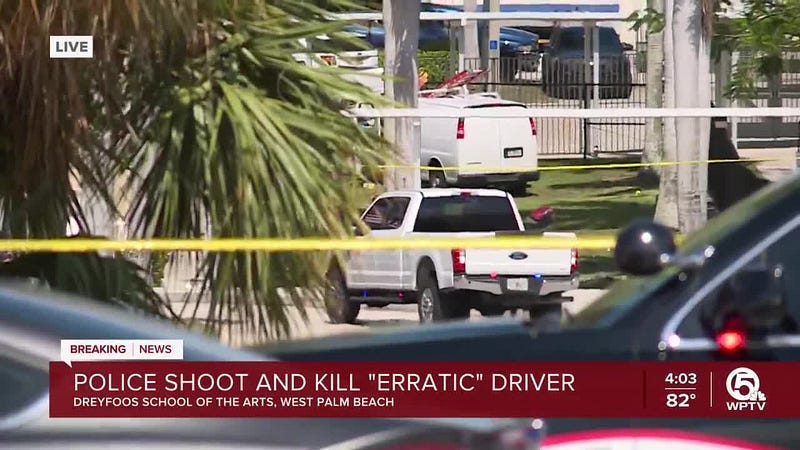
Armed Teachers
Pro: Well trained and armed teachers could stop a shooter before police arrive.
Con: In most cases, students commit shootings meaning that the staff are armed for the purpose of shooting a student. An armed teacher might be tempted to brandish their weapon during a fight in the classroom or a threat of violence. Students may also have an opportunity to access a teacher’s weapon that is left unattended. Students may be physically stronger and more agile than a teacher. Situations could occur where a teacher is deliberately debilitated by a determined student intent on violence (e.g., striking teacher from behind by surprise and taking gun). If a teacher is carrying a concealed handgun, he or she probably takes the holster off to sit down in the bathroom. Bathrooms are one of the most common places for people, including police officers, to accidentally leave behind a weapon.
Bleeding Control Kits
Pros: Kits with tourniquets and chemical dressings can provide rapid bleeding control for gunshot and stab wounds.
Cons: Tourniquets can only be applied to the arms or legs. These kits have limited utility of a student shot in the head, neck, chest, or abdomen. They have no use for treating minor injuries. Note: studies showing the effectiveness of tourniquets are from combat environments where soldiers have extremity injuries that need rapid bleeding control while wearing body armor that protects their torso, neck, and head.
Ballistic windows, chalk boards, blankets, shields
Pros: Physical barriers will stop bullets (based on materials and rating) that are fired through them and protect whoever is behind the barrier.
Cons: If a student pulls out a gun inside the classroom, the shooter can use ballistic protection to barricade the room and/or protect themselves from police. Most shootings happen in common areas of the school like hallways, cafeterias, entryways, or parking lots where these ballistic barriers are not located.
Smoke screens
Pros: Seriously?
Cons: Figuring out how to set off the smoke screen is a perfect senior prank. If the system activates by accident, it would create mass panic and crowd related crush/trampling injuries in the hallway.
Facial recognition cameras to detect intruders
Pros: CCTV system can automatically detect someone who isn’t allowed on the campus.
Cons: Most shooters are students, former students, or other people who are allowed to be on the campus. The system would not flag these people as a threat.
Clear backpacks
Pros: None.
Cons: Students can put a bag or jacket inside the clear backpack, then hide a weapon inside that.
Curved hallways, alcoves, and “wing walls”
Pros: Students can take cover in hallways and shooter will not have a clear line of sight.
Cons: Shooter can take cover from police officers who will be exposed to gunfire when they try to move toward the attacker.
Weapons lockers inside schools (teacher has key)
Pros: Trained teachers and SROs can quickly get access to weapons (maybe not a pro)
Cons: A student planning a shooting doesn’t need to bring guns into the school, they just need to get a key from a teacher or figure out the combination.
Fortified classroom door (drop bar, bullet proof door, one way locks)
Pros: A shooter in the hallway cannot get inside a classroom.
Cons: A shooter can barricade inside a fortified classroom. Alternately, if a shooter who plants bombs or sets fires, students are trapped inside rooms that they cannot easily exit.
Single point of entry
Pros: All students and visitors need to enter through the same door where they can be screened by security.
Cons: Creating crowds and lines by the single door to get in allows outside to target large number of students who don’t have anywhere to “run, hide, or fight”. Single entry point screening can be easily bypassed by going in another door, window, or throwing a bag over the fence then getting after going through security.
Summary
Almost every school security solution has cons that can potentially make any active shooter situation far worse. Many of these ideas are utterly ridiculous when you take time to think about them. Any investments in school security need to be carefully analyzed and coordinated with everyone who is involved in school safety. The best solutions, though also incredibly complicated, are crisis intervention and threat assessment programs that stop shootings before they happen. The most important thing to remember is there’s no simple solution that can be purchased to stop the next school shooting.
David Riedman is the creator of the K-12 School Shooting Database and a national expert on school shootings. Listen to my recent interviews on Freakonomics Radio and the New England Journal of Medicine.

